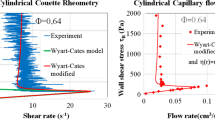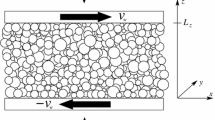Abstract
A new method for testing the strength of cells against fluid shear stress by using a long capillary column was proposed. The trajectories of cells in the column were simulated by introducing the Brownian motion model. The Brownian motion was performed by the generation of random numbers. The mean exposure time to shear stress and the mean shear stress acting on the surface of cells were discussed by the result of computer simulation. The mean shear stress acting on the surface of cells flowing in the capillary column was estimated as 4/3-fold of the shear stress at the column wall provided that the ratio of the cell radius to the column radius does not exceed 0.08. The effectiveness of this new method for testing the strength of cells against fluid shear stress was shown.
Similar content being viewed by others
Abbreviations
- a m:
-
radius of cell
- c :
-
constant
- E :
-
distribution function
- L m:
-
length of capillary column
- M :
-
number of division
- N :
-
number of division
- p :
-
probability
- Q m3/s:
-
flow rate
- R m:
-
radius of capillary column
- r m:
-
radial position
- t s:
-
time
- T s:
-
exposure time
- T m s:
-
mean exposure time
- T 0 s:
-
mean residence time
- μ m/s:
-
axial velocity
- u m m/s:
-
cross-sectional flow velocity
- z m:
-
axial position
- γ s−1 :
-
shear rate
- γ w s−1 :
-
shear rate at wall
- μ Pa s:
-
viscosity
- θ :
-
spherical coordinate
- φ :
-
spherical coordinate
- τ Pa:
-
shear stress
- τ m Pa:
-
mean shear stress
- τ w Pa:
-
shear stress at wall
References
Bussolari, S. R.; Dewey Jr., C. F.; Gimbrone Jr., M. A.: Apparatus for subjecting living cells to fluid shear stress. Rev. Sci. Instrum. 53 (1982) 1851–1854
Crouch, C. F.; Fowler, H. W.; Spier, R. E.: The adhesion of animal cells to surfaces — The measurement of critical surface shear stress permitting attachment or causing detachment. J. Chem. Tech. Biotechnol. 35B (1985) 273–281
Nomura, H.: Ishikawa, C.: Komatsuda, T.; Ando, J.; Kamiya, A.: A disk-type apparatus for applying fluid shear stress on cultured endothelial cell. Biorheology 25 (1988) 461–470
Stathopoulos, N. A.; Hellums, J. D.: Shear stress effects on human embryonic kidney cells in vitro. Biotechnol. Bioeng. 27 (1985) 1021–1026
Born, C.: Zhang, Z.; Rubeai, M. A.; Thomas, C. R.: Estimation of disruption of animal cells by laminar shear stress. Biotechnol. Bioeng. 40 (1992) 1004–1010
Shiragami, N.: A simple and rapid method for detecting contaminants in a bioreactor. Bioprocess Eng. 5 (1990) 115–117
Cox, R. G.; Zia, I. Y. Z.; Mason, S. G.: Particle motions in sheared suspensions — XXV. Streamlines around cylinders and spheres. J. Colloid Sci. 27 (1968) 7–18
Cherry, R. S.; Kwon, K. Y.: Transient shear stresses on a suspension cell in turbulence. Biotechnol. Bioeng. 36 (1990) 563–571
Author information
Authors and Affiliations
Rights and permissions
About this article
Cite this article
Shiragami, N. Development of a new method for testing strength of cells against fluid shear stress. Bioprocess Engineering 10, 47–51 (1994). https://doi.org/10.1007/BF00373535
Received:
Issue Date:
DOI: https://doi.org/10.1007/BF00373535




